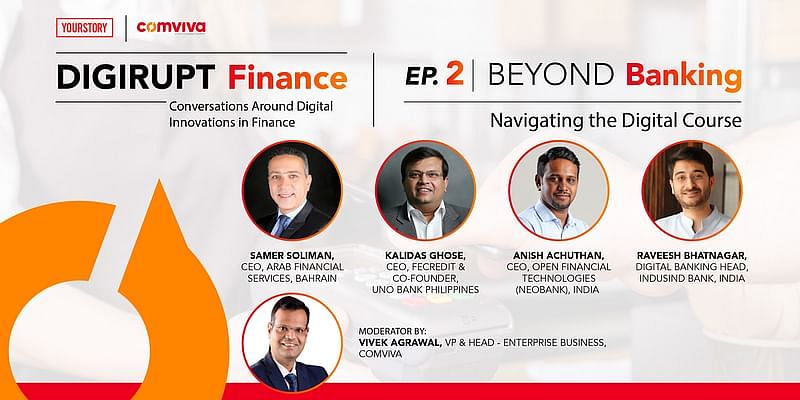The year 2020 is likely to go down in history as one when the COVID-19 pandemic transformed the way banks across the globe operated, as digital platforms swooped in to save the day. With lockdowns and other restrictions forcing people to stay at home, FinTech ventures rose to the occasion by launching a slew of digital solutions that enabled them to reimagine customer experience.
The shift was in tandem with the way innovation has been galvanising traditional banking systems over the past few years as banks warmed up to disruptive solutions like open application programming interfaces (APIs) and artificial intelligence-powered interfaces.
The popularity of digital banking solutions have paved the way for many success stories where neobanking ventures enabled customers to enjoy a better experience with disruptive solutions. According to a study by Juniper Research, the total number of digital banking users globally will exceed 3.6 billion by 2024, up from 2.4 billion in 2020 i.e. a 54 percent increase.
The second episode of Digirupt Finance: Conversations around Digital Innovations in Fintech, hosted by Comviva in association with YourStory, focussed on how digital banking has been transforming customer journeys and how FinTech ventures and banks could together drive growth in the segment. The panel discussion was titled ‘Beyond Banking: Navigation the Digital Course’ and was moderated by Vivek Agrawal, VP and Head of Enterprise Business at Comviva.
The panel featured Kalidas Ghose, Vice Chairman and CEO, FE Credit and Co-founder, UNO Bank Philippines; Samer Soliman, CEO of Arab Financial Services, Bahrain; Anish Achuthan, Co-founder and CEO, Open Financial Technologies and Raveesh Bhatnagar, SVP & Head of Digital Banking, IndusInd Bank.
Watch the full conversation here:
Here are a few key highlights of the discussion:
The case for boosting backend innovation
Talking about how Vietnam has over 160 million mobile connections for a 100-million populace, FE Credit’s Kalidas Ghose said that the running joke was that every person in the country was born with a mobile phone in their hand. “While launching FE Credit in Vietnam, it was evident to us that our entire interface, which until now was very intermediary-driven, would have to be completely digital,” Kalidas said while recounting the company’s early days. FE Credit is among the biggest and fastest growing consumer finance companies in the ASEAN region and has served more than 12 million customers till now.
He said that the startup’s key focus area while starting out was to change the way it interacted with customers. “We started looking at facilities like how we can secure a loan for a new customer in 10 minutes in a way that we can easily get their details without compromising with underwriting standards. During our planning, we realised that none of this would be possible without backend innovation.”
FE Credit brought in a business process management solution and configured the entire customer journey, so that the platform could interface with the APIs on the front-end system. “As we started leveraging technologies like robotic automation, conversational artificial intelligence, we were able to transform the customer journey,” he added.
Open banking to drive future growth?
Samer Soliman, CEO, Arab Financial Services (AFS) — a leading FinTech service provider in the Middle East region — said that if a bank wasn’t investing in digital transformation, then it was likely to lose customers.
“Given how banks are enriching user experience with data and other capabilities, open banking or open finance will be a big deal going forward and will not only drive digital banking, but will also empower neobanks with more capabilities,” Samer added.
How the COVID-19 pandemic impacted the neobanking space
Delving into the impact of the pandemic on neobanking platforms, Anish Achuthan, Co-Founder and EO, Open Financial Technologies said that he saw several businesses shutting down during the first three months after COVID-19 struck. “At the same time, we also saw a huge digital transformation in terms of financial automation as enterprises realised the importance of digitalising their finances. We saw the number of accounts being opened online rise by 20 percent in 2020.” Open Financial Technologies is Asia’s first neobanking platform and caters to the SME segment. It helps SMEs automate various business processes around banking and payments.
Talking about the pandemic’s effect on the profitability of neobank ventures, he said that Open Financial Technologies had a subscription model that charged for services like expense management and subscriptions, among other revenue-sharing components that were free of charge until April 2020.
“We started monetising these services during the pandemic. Over months, the revenue from the subscription-based model and revenue-sharing components has surged by around 400X from 0,” he explained.
Exploring partnerships with FinTech ventures vs Launching a digital platform
Raveesh Bhatnagar, SVP & Head of Digital Banking at IndusInd Bank said that banks need to ensure that they are keeping up with FinTech ventures, which are catering to over 40 lakh consumers who are accessing banking services via mobile handsets, if they are eyeing long-term growth. But, that doesn’t mean that creating a digital bank is the only way out. They can always explore the scope for partnerships.
“For example, a bank can compete with FinTech ventures with a digitally-adapted offering and tap into the trust of their customers, while investing in front-end and back-end innovation. Once they’ve established that platform, they could look for a neobanking venture that offers a different value proposition and complements their offerings. Banks can leverage their core APIs and power a neobank’s journey as well,” he added.
The future belongs to personalisation
Drawing from his observations, Samir said that the digital banking space is likely to see more personalisation of customer services in the future.
Samir said that customers would seek more personalised experiences and the transformation or evolution of digital banks to address such personalisation will play a critical role in customers’ decisions. “Moreover, as hundreds of digital banks evolve, the customer will get to choose from a wide pool. The question that comes to my mind is whether such transformation would lead to a digital bank aggregator?”
Agreeing with him, Anish said that while hyperpersonliasatin is likely to be a game changer in the space, digital baking is likely to see a shift towards solutions focusing on lending and wealth management.
“Neobanks like us now have more access to payables and receivables and the frequency with which they are paid is also higher. By combining that with traditional underwriting, you can get more opportunities to create more intuitive lending products,” he added.
If you’re a FinTech startup, banking professional or FinTech enthusiast looking to transform your business into a digital-first enterprise by 2025, stay tuned for the next episode of Digirupt Finance on ‘‘Digital Payments Push in the Connected World’ on July 14, 2021.
Don’t miss Episode 03: ‘Digital Payments Push in the Connected World’ Register Now










